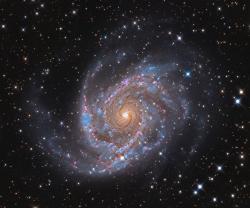
Howdy, Stranger!
It looks like you're new here. If you want to get involved, click one of these buttons!
BlockHead
About
- Username
- BlockHead
- Joined
- Visits
- 257
- Last Active
- Roles
- Member, Administrator
Comments
-
Hi Rich, You may want to look at the other recent thread on this in this forum.A member had the some question... 1. You need to make certain you used exactly the same reference that your star aligned images used for your comet alignment reference. …
-
I don't think so... but WBPP might be tasking an additional piece of logic. One thing that will make it take long is the generation of reference frames. If you have this doing it automatically and you do not adjust the settings..this can definitely …
-
Yeah, good. I am pretty sure I mention this in my video. The "Comet Aligned" is describing the operand. It make sense if you think about from the operand point of view. Concerning the offset..it really does mean there is a discrepancy in chosen ref…
-
Yes... you need to pay particular attention to reference frames. Let me ask you these questions: 1. What was the StarAlignment reference frame that all of the images are aligned to?2. What frame did you choose to align your comet images to as a refe…
-
What in the world is that??!!I honestly do not know how you did that. Does the raw data look OK?You might need to make a video..or more screenshots to show this. I have no idea. -the Blockhead
-
The problem with the meridian flip is that CometAlignment will not work well... likely due to the fact your mount is not geometrically perfect. So...in the case of meridian flips... definitely go from the registered data. You will not be able to get…
-
No. Right now we are on a two year cycle. So the next one would be in 2024 with a date to be determined (probably the fall).-the Blockhead
-
Yeah... pixel math does not keep that information when creating new images. You can copy the astrometric solution from one of the original images to the newly created one if you want using the CopyCoordinates script. -the Blockhead
-
Indeed...-the Blockhead
-
Yeah... you need to figure all of that stuff out from the activity of the comet (shorter if you want detail), its motion (longest you can go without streaking), get good separation between stars (cycling filters if mono)...etc. So there is no prescr…
-
The answer(s) is/are now available.
-
This stacked image looks great. I do not see an issue.You are familiar with the concept concerning increased contrast of screen stretched images after DBE?(just making certain this isn't the issue) -the Blockhead
-
At the moment I cannot look at the data... I am in the midst of finalizing this new method of comet processing (OSC). Publishing videos and materials now... If you make a link to the data file... I can perhaps check it out later.-the Blockhead
-
Are the whitish things in this image stars?This is OSC?Are you drizzling? (1x1)Any other processing after getting an integrated image?Is NXT in play (or possible?) -the Blockhead
-
These videos are being uploaded NOWgoing as fast as I can.This method is entirely newand "adam block" thing It is a puzzle isn't it? -the Blockhead
-
Interestingly... OSC WITH drizzle is really complex and does not shorten any processing time. Don't be fooled...I will be showing this very soon.-the Blockhead
-
By the way..I will add that I do not think your color image was blended correctly.Your stars are very small in the color image. I think you forgot to stretch the star image when you blended the stars and the starless nebula. -the Blockhead
-
So now... show the LRGB result of these two images.There should be some color... but I doubt the result will be desirable. I do not think this data is stretched well in terms of the color image. -the Blockhead
-
Hi Dick, I think I need more information... but here are some answers. 1. At 00:45 seconds in step 6 I state the reason the astrometric solution (using ImageSolver) is necessary. It is to be able to match stars in your image to those in a catalog (…
-
You certain you do not want to so LRGB Combination in this state.. your Luminance does not appear to be stretched. I can see a green line...-the Blockhead
